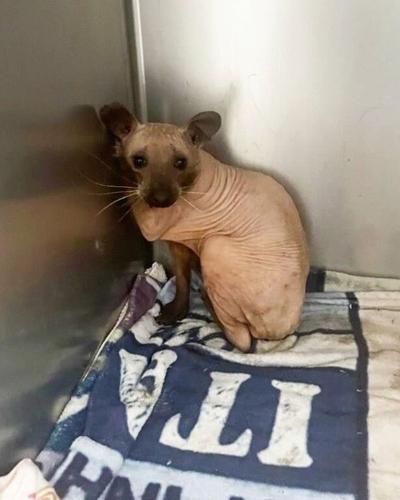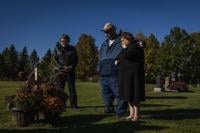HALIFAX - A rare bald raccoon is in the care of a Nova Scotia shelter, where staff hope she'll grow her fur coat – including a bandit-like, black streak across her eyes.
Hope Swinimer, the director of Hope for Wildlife, says the furless mammal has been named Rufus after a naked, squeaky mole-rat character in the children's television show "Kim Possible."
It turned out after closer examination Rufus is in fact female, but the name has remained as the pink-hued raccoon is proving to have an entertaining character in keeping with her cartoon namesake.
A couple in West Arichat discovered the shivering, three-kilogram female in their backyard last week and brought her to a Cape Breton veterinary clinic, where she received fluids before being sent to the wildlife shelter in Seaforth, N.S.
Swinimer says skin tests have determined Rufus's lack of fur — a condition she refers to as alopecia — may be a genetic condition rather than the result of parasites or other causes.
The shelter director says that with good food and living conditions, the hope is for Rufus to gradually grow back her fur and be released back into the wild.
If that proves impossible, however, she says the shelter may provide Rufus with an enclosed, outdoor habitat with her own hut.
In the meantime, the raccoon has gone from being "down and out upon arrival" to showing her dexterity by carefully removing plastic duct covers and scurrying through the ductwork in the building.
"We were panicking for a few short hours ... but she got hungry and came out. She's getting quite feisty and we've seen a big improvement since she first arrived," said the shelter director.
Swinimer has been providing care to injured or ailing wildlife for over 30 years and says while she's seen earlier cases of alopecia in raccoons, Rufus is the most extreme example.
She said in the past when raccoons have lacked hair, they at least had their distinctive facial patterns across the eyes, but Rufus is even bald in that area.
"It's just tufts of fur around the snout, ankles and feet. This is a severe case," said Swinimer.
The case highlights the crucial nature of fur and feathers to wild animals, she explained.
"If they don't have that nice fur coat, they won't survive. If compromised, they'll succumb to frostbite."
Several of the animals that have become permanent residents of the shelter, which currently has 250 occupants, have had special habitats created for them.
That includes a 10-metre long space with a view of the ocean for Edward the bald eagle, who after surgery never regained the ability to fly more than a short distance. There is also a visually impaired fox that lives in a small, outdoor enclosure.
If Rufus moves in permanently, her outdoor home will include trees, mulch and a space to crawl into and keep warm, said Swinimer.
"It will include fun things she wouldn't have in the wild, such as hammocks and nesting boxes," she added.
Swinimer said there are many things that can be learned from such cases. For example, if Rufus's fur does grow back, that could mean there is something in the environment causing the loss that could be investigated.
And for those who wonder why her centre would assist an injured or sick animal that's not an endangered species, the shelter director said her policy is not to discriminate.
Most of the animals that come to the shelter have been injured by humans, and the staff provide care regardless of whether they are rare species.
"We do so much damage to our natural world it's good to be able to give back and do whatever we can, for whatever the reason," Swinimer said.
This report by şĂÉ«tvwas first published March 16, 2024.








































